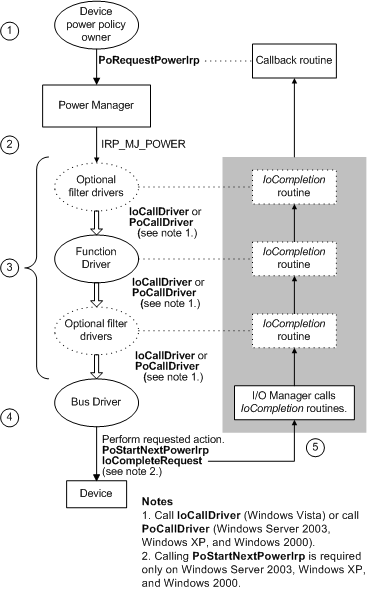Power IRPs for Individual Devices
A device power IRP specifies major IRP code IRP_MJ_POWER, one of the minor power IRP codes listed below, and the value DevicePowerState in the Power.Type member.
All drivers in a device stack receive such IRPs; normally, only the device power policy manager can send these IRPs. However, the power manager can send a device power IRP when performing idle detection on behalf of a device, as explained in Using Power Manager Routines for Idle Detection.
A driver sends a device power IRP for any of the following reasons:
To query or change the device power state in response to a system power IRP
To put the device in a sleep state to conserve power
To return the device to the working state after it has been asleep
To enable the device to awaken in response to an external signal
To get a power sequence value when powering up a device
The following figure shows the sequence of steps that occur to send, forward, and complete a device power IRP.

As the previous figure shows, a device power IRP is sent, forwarded, and completed in the following steps:
The device power policy owner calls PoRequestPowerIrp to allocate a device power IRP, specifying the PDO that is the target of the IRP and a callback routine to be invoked when the IRP is complete.
The power manager allocates a device power IRP and sends it to the top driver in the device stack for the target PDO.
The driver performs the following actions:
Sets an IoCompletion routine if one is necessary.
Calls PoStartNextPowerIrp (Windows Server 2003, Windows XP, and Windows 2000) if a completion routine is not used. Beginning with Windows Vista, this call is not required and such a call performs no power management operation.
Calls IoCallDriver (Windows 7 and Windows Vista) or calls PoCallDriver (Windows Server 2003, Windows XP, and Windows 2000) to pass the IRP down to the next-lower driver.
Each driver in the stack does this until the IRP reaches the bus driver. If a driver must fail the IRP, it should do so immediately and call IoCompleteRequest.
The bus driver, which maintains the device PDO, performs the requested action, and then calls IoCompleteRequest to complete the IRP. A bus driver can fail a device power-up IRP if a device is removed or in the process of being removed.
The I/O manager calls IoCompletion routines that were set by drivers as they passed the IRP down the stack. After all the IoCompletion routines have been called, the callback routine is run.
For more information about device power IRPs, see Managing Power for Individual Devices and Supporting Devices that Have Wake-Up Capabilities. For details on the power sequence IRP, see IRP_MN_POWER_SEQUENCE.